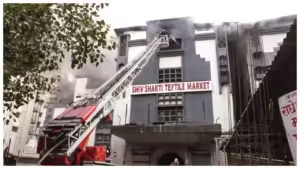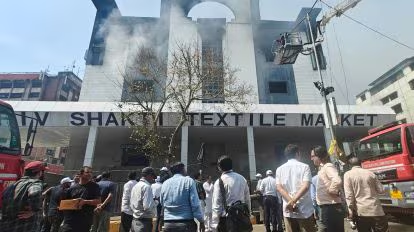Massive Fire continuous after 36 hours at Shiv Shakti Textile Market in Surat : A devastating fire broke out at the Shiv Shakti Textile Market in Surat, Gujarat, leading to unprecedented destruction and significant economic losses. The inferno, which persisted for over 32 hours, has been described as one of the most catastrophic market fires in Surat’s recent history.
Chronology of the Incident
The initial outbreak occurred on February 25, 2025, in the market’s basement, where large quantities of textile stock were stored. Firefighters managed to control this blaze after several hours. However, on the morning of February 26, around 7:00 AM, the fire reignited, rapidly spreading throughout the four-story building. This resurgence led to a prolonged firefighting operation that lasted over 32 hours.
Extent of Damage
The Shiv Shakti Textile Market houses approximately 853 shops. Reports indicate that over 500 of these establishments were engulfed in the flames, with 450 shops completely reduced to ashes. The financial ramifications are staggering, with losses estimated between ₹400 crore to ₹700 crore. This market is predominantly a hub for sarees, especially nylon polyester sarees and wedding sarees, catering primarily to traders from South India.
Also Read: Pi Network Mainnet Launch: Major Listings & Price Movements in Focus
Firefighting Efforts
The firefighting operation was extensive and challenging. Over 40 fire trucks were deployed, collectively using more than 40 lakh litres of water to combat the blaze. Firefighters from across South Gujarat were called in to assist. The presence of synthetic fabrics, which are highly flammable, exacerbated the situation, making it more difficult to contain the fire. Additionally, the market’s infrastructure, including narrow passages and shops in the basement, posed significant challenges to the firefighting teams.
Structural Integrity and Safety Concerns
The intense heat from the fire has severely compromised the structural integrity of the market building. Steel structures melted, weakening the slabs and columns, particularly on the fourth and fifth floors. Authorities have deemed it unsafe for individuals to enter the premises until a thorough structural assessment is conducted. The Surat Municipal Corporation (SMC) plans to have structural engineers evaluate the building to determine the necessary steps moving forward.

Response from Authorities and Associations
In the aftermath of the fire, the Federation of Surat Textile Traders Association (FOSTTA) convened a meeting with its 41 directors to address the crisis. They formed the Shiv Shakti Textile Market Relief Committee, which will collect donations from the public to support the affected traders. The committee has also appealed to both the state and central governments for assistance, emphasizing the need for swift processing of insurance claims and the provision of low-interest bank loans to help traders restart their businesses.
Investigations and Future Precautions
The recurrence of the fire has raised concerns about the market’s safety protocols and infrastructure. Initial investigations suggest that unauthorized textile shops had encroached upon the market’s parking area, potentially contributing to the rapid spread of the fire. Authorities are now scrutinizing these encroachments and the overall compliance of the market with fire safety regulations.
Furthermore, there are indications that the market lacked adequate fire safety measures, such as water sprinklers, which could have mitigated the severity of the fire. The SMC has announced plans to conduct a comprehensive survey of fire safety compliance in markets across the city to prevent such incidents in the future.
Impact on the Community
The fire has had a profound impact on the local community. Many traders have lost their livelihoods, with some stating that they have been reduced from millionaires to paupers overnight. The market not only served as a commercial hub but also provided employment to thousands, including shop owners, workers, and ancillary service providers. The loss extends beyond the immediate financial implications, affecting the socio-economic fabric of the region.
